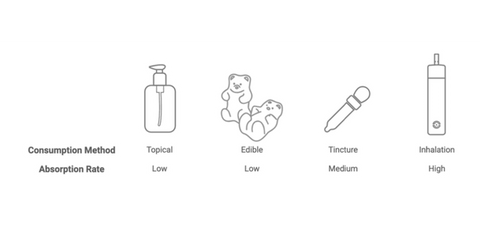Since the 2018 Farm Bill, more and more companies have added CBD products to their inventory. Cannabis doesn’t always look like dense green buds in a ziplock bag anymore. These days, cannabinoids like CBD and THC can come in all sorts of delivery methods that range from vaporizers to athletic wear.
One of the most common forms of CBD growing in popularity are CBD gummies. Things like capsules, beverages, and sweet confections are by far some of the most popular forms of cannabidiol out there, but just how effective are they at getting CBD into your system?
What Is CBD, And How Does It Work?

Before we can answer the question of how effective edible CBD is, we first have to get an understanding of how CBD works to begin with.
CBD is a chemical compound derived from the cannabis plant. These types of molecules are called cannabinoids. Unlike THC (another cannabinoid and the active ingredient in marijuana) consuming CBD doesn’t result in intoxicating effects. The difference has to do with the way both chemicals interact with our endocannabinoid system (ECS). This complicated system of neurotransmitters and neurotransmitter receptors govern many key bodily functions (ex. sleep patterns, mood, and appetite) by sending hormonal signals to the CB1 and CB2 neurotransmitter receptors located throughout the brain and central nervous system. When cannabinoids like CBD enter our body, they mimic these signals by interacting with these CB1 and CB2 receptors, influencing the functions of our body. However, the way you get the CBD into your body can have a dramatic influence on the way the effect takes place.
CBD and Bioavailability

Bioavailability measures what percentage of drug is actually able to get used by the body. Compared to some other pharmaceuticals, CBD has a relatively low bioavailability. That means that a significant portion of the CBD doesn’t end up having an effect at all.
This is particularly true when examining orally administered CBD. Edible CBD such as gummies or capsules can have bioavailability as low as 6%. This means that taking a 20 mg edible could potentially only provide 1.6 mg of effective CBD. You see, when you orally consume CBD, the chemical first has to navigate the complex labyrinth of the digestive system before it can be metabolized and enter the bloodstream. So while simply eating a gummy or drinking a CBD beverage may seem like a convenient way to use CBD, you’ll likely have to take much higher doses to reach a comparable effect of other administration methods. Not only does this make dosing exponentially more complicated, but it can also quickly get expensive.
Another common option for administering CBD are sublingual tinctures. These bottles of golden CBD liquid come with a dropper top that allows consumers to either administer the cannabinoid orally or sublingually. Adding the dropper to your morning coffee or simply swallowing the CBD oil essentially works the same way as an edible since the oil still has to be digested before it can take effect. However, it can also be used sublingually. To use CBD oil sublingually, you release the dropper directly under your tongue for 60 seconds, allowing the salivary glands in your mouth to absorb the CBD.
Since sublingual administration circumvents the digestive system, it has better bioavailability than edible CBD (but it isn’t the most effective way). Inhalation methods like smokable hemp flower or the elon® CBD delivery system have the highest bioavailabilities of any intake method by far. Not only do inhalation methods give you more bang for your buck by providing more effects at lower doses, but it also has a much quicker onset time. This is particularly relevant for those using CBD therapeutically and who need fast-acting relief.
To sum things up, edible CBD may seem like a convenient option; however, it’s not nearly as effective as inhalation due to its low bioavailability.



